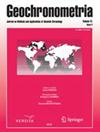柬埔寨湄公河漫滩细粒河流沉积物OSL测年的适用性
IF 0.9
4区 地球科学
Q3 Earth and Planetary Sciences
引用次数: 4
摘要
摘要细粒(4–11μm)河流沉积物的光激发光(OSL)测年很少尝试,但对于限制泥质泛滥平原的演变至关重要。本研究调查了OSL测年法在湄公河细粒沉积物中的适用性,柬埔寨基于一个非常年轻的(比细粒石英OSL年龄估计值早200年)。细粒石英OSL的年龄与从单粒石英OSL获得的最小年龄一致。这些结果得到了现代细粒洪泛平原矿床中测得的通常较小的残余剂量(<0.1 Gy)的支持。这表明湄公河(柬埔寨)的细粒沉积物在沉积时充分漂白,可以产生可靠的石英OSL年龄,用于确定泛滥平原的年代。细粒石英的充分漂白部分是由于运输距离长,也可能发生在其他大型河流系统中。本文章由计算机程序翻译,如有差异,请以英文原文为准。
Applicability of OSL Dating to Fine-Grained Fluvial Deposits in the Mekong River Floodplain, Cambodia
Abstract Optically stimulated luminescence (OSL) dating of fine-grained (4–11 μm) fluvial sediments is rarely attempted but is crucial for constraining the evolution of mud-dominated floodplains. This study investigated the applicability of OSL dating to fine-grained deposits in the Mekong River, Cambodia based on a very young (<600 yr) point-bar to riverbank succession and modern flood deposits. In succession, fine-grained quartz OSL provided the youngest ages, whereas age estimates by multi-grain sand-sized quartz OSL, and feldspar and polymineral infrared-stimulated luminescence are >200 years older than the fine-grained quartz OSL age estimates. Ages of fine-grained quartz OSL are concordant with the minimum ages obtained from the single-grain quartz OSL. These results are supported by the generally small residual doses (<0.1 Gy) measured in modern fine-grained flood-plain deposits. This indicates that fine-grained sediments in the Mekong River (Cambodia) are sufficiently bleached at deposition and can yield reliable quartz OSL ages for establishing the chronology of the floodplain. The sufficient bleaching of fine-grained quartz partly results from the long transport distance and may also occur in other large river systems.
求助全文
通过发布文献求助,成功后即可免费获取论文全文。
去求助
来源期刊

Geochronometria
地学-地球科学综合
CiteScore
2.20
自引率
0.00%
发文量
1
审稿时长
>12 weeks
期刊介绍:
Geochronometria is aimed at integrating scientists developing different methods of absolute chronology and using them in different fields of earth and other natural sciences and archaeology. The methods in use are e.g. radiocarbon, stable isotopes, isotopes of natural decay series, optically stimulated luminescence, thermoluminescence, EPR/ESR, dendrochronology, varve chronology. The journal publishes papers that are devoted to developing the dating methods as well as studies concentrating on their applications in geology, palaeoclimatology, palaeobiology, palaeohydrology, geocgraphy and archaeology etc.
 求助内容:
求助内容: 应助结果提醒方式:
应助结果提醒方式:


